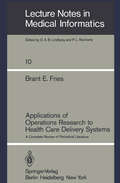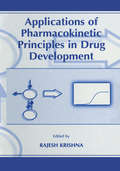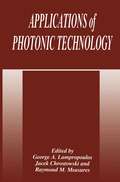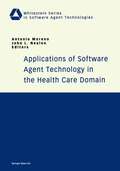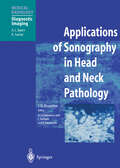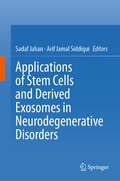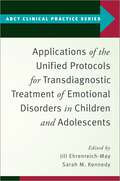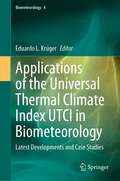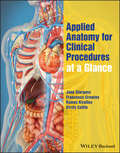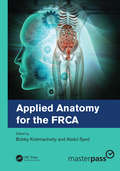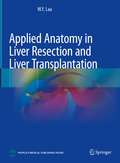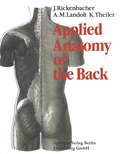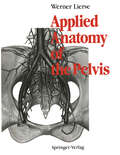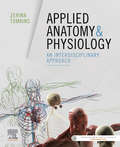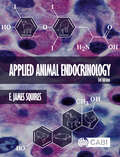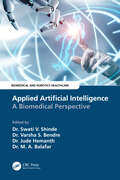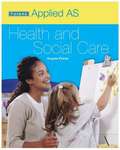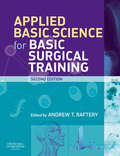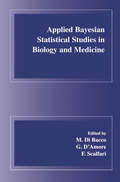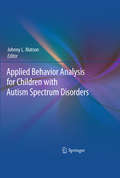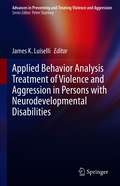- Table View
- List View
Applications of Operations Research to Health Care Delivery Systems: A Complete Review of Periodical Literature (Lecture Notes in Medical Informatics #10)
by Brant E. FriesApplications of Pharmacokinetic Principles in Drug Development
by Rajesh KrishnaThis volume is an important advancement in the application ofpharmacokinetic (PK) and pharmacodynamic (PO) principles to . drug development. The series of topics presented deal with the application of these tools to everyday decisions that a pharmaceutical scientist encounters. The ability to integrate these topics using PK and PO methods has optimized drug development pathways in the clinic. New technologies in the areas of in vitro assays that are more predictive of human absorption and metabolism and advancement in bioanalytical assays are leading the way to minimize drug failures in later, more expensive clinical development programs. of Pharmacokinetics and pharmacodynamics have become an important component understanding the drug action on the body and is becoming increasingly important in drug labeling due to it's potential for predicting drug behavior in populations that may be difficult to study in adequate numbers during drug development. The ability to correlate drug exposure to effect and model it during the drug development value chain provides valuable insight into optimizing the next steps to derive maximum information from each study. These principles and modeling techniques have resulted in an expanded and integrated view of PK and PO and have led to the expectations that we may be able to optimally design clinical trials and eventually lead us to identifying the optimal therapy for the patient, while minimizing cost and speeding up drug development. There is wide utility for the book both as a text and as a reference.
Applications of Photonic Technology
by J. Chrostowski G. A. Lampropoulos R. M. MeasuresIn this book we present a snapshot of the state of the art in photonics in 1994, showing typical applications and emerging new ones; discussing the key technologies behind these applications, their limitations, and prospects. The articles in this book are extended versions of the papers presented at the first International Conference on Applications ofPhotonic Technology (ICAPT'94), held in Toronto, Canada, on June 21-23, 1994. Photonics has been recognized as one of the key technologies for the 21 st century, as electronics was the technology of the 20th centrury and electrical engineering changed the life of people in the 19th century. According to the recent report of the Organization for Economic Cooperation and Development in Paris (OECD), the market for photonics will grow dramatically in the next 10 years with an expected world-wide expenditure of US $230 billion from some US $30 billion in 1992. The explosion of information technology was the largest driving force for the deployment of photonic technology. It created insatiable demand for ever-higher data transmission and processing rates, which cannot be sustained by electronics alone. Boosted by the enonnous investment of the telecommunications and defense industries, the demand for photonics (or optoelectronics) is steadily increasing. It is solidly established in the long haul communications, laser printers and CD-ROMs.
Applications of Software Agent Technology in the Health Care Domain (Whitestein Series in Software Agent Technologies and Autonomic Computing)
by Antonio Moreno John L. NealonThis volume contains a collection of papers that provides a unique, novel and up-to-date overview of how software agents technology is being applied in very diverse problems in health care, ranging from community care to management of organ transplants. It also provides an introductory survey that highlights the main issues to be taken into account when deploying agents in the health care area. The intended audience includes graduate and postgraduate students specializing in artificial intelligence and researchers interested in the application of new technologies.
Applications of Sonography in Head and Neck Pathology (Medical Radiology)
by F. Weill C. Raffaelli O. DassonvilleThroughout the world, sonography is often the first and sometimes the only imaging modality to be used after clinical examination. This is particularly true for the cervical region. This book reviews the sonographic features of the cervical structures, including the thyroid, parathyroids, salivary glands, lymph nodes, larynx and hypopharynx, and blood vessels. Detailed morphological descriptions of numerous pathological processes are provided, followed by thorough discussion of differential diagnostic problems. The role of all of the new technical modalities, including high-definition gray scale, enhanced color Doppler, and ultrasound contrast agents, is fully considered. The closing chapter is devoted to the use of cervical sonography in pediatrics.
Applications of Stem Cells and derived Exosomes in Neurodegenerative Disorders
by Sadaf Jahan Arif Jamal SiddiquiThis book explores the therapeutic approaches of stem cells and stem cell-derived exosomes against neurodegenerative disorders (NDDs). The initial chapters introduce different neurodegenerative diseases and discuss the mechanistic aspects of their progression. The subsequent chapters cover strategies for the isolation, characterization, and differentiation of stem cells. In turn, the book reviews the protective role of stem cells against neurological disorders and examines regenerative approaches to treat neurological diseases using mesenchymal stem cells. The book also presents induced pluripotent stem cell (iPSC) technology for cellular therapy, drug screening, and in-vitro modeling of neurodegenerative diseases. Lastly, the book discusses the role of stem cells and derived exosomes as a novel therapeutic agent against Alzheimer's and Parkinson's disease and in associated signaling molecules involved in neuroprotection. This book is an invaluable source for researchers working towards understanding the potential of stem cell therapy in neurodegenerative disorders.
Applications of the Unified Protocols for Transdiagnostic Treatment of Emotional Disorders in Children and Adolescents (ABCT Clinical Practice Series)
by Jill Ehrenreich-May Sarah M. KennedyThe Unified Protocols for Transdiagnostic Treatment of Emotional Disorders in Children (UP-C) and Adolescents (UP-A) are evidence-based interventions originally designed to target core dysfunctions underlying emotional disorders, such as anxiety and depressive disorders, in children and adolescents. However, the UP-C and UP-A re increasingly being used to address other diagnostic clusters and problem areas that share these same core dysfunctions in a diverse range of delivery settings and cultural contexts. Applications of the Unified Protocols for Transdiagnostic Treatment of Emotional Disorders in Children and Adolescents is a practical guide for clinicians and researchers on applying the core principles of the UP-C and UP-A to treat children and adolescents with a broad range of emotion disturbance across settings in which youth typically receive care, including community mental health settings, pediatric primary care, and telehealth. In addition to providing an overview of the rationale for using UP-C and/or UP-A with each presenting problem or within each delivery setting, chapters provide detailed, step-by-step guidance on adapting and applying the UP-C and UP-A for their particular problem area, delivery setting, or cultural context. Chapters include case examples, suggestions for overcoming potential barriers in clinical delivery, and practical "tip sheets" for clinicians. When used in conjunction with the UP-C and UP-A Therapist Guide and Workbooks, this volume is an essential resource for clinicians using transdiagnostic interventions to treat diverse, complex, and comorbid clients in real-world therapy settings.
Applications of the Unified Protocols for Transdiagnostic Treatment of Emotional Disorders in Children and Adolescents (ABCT Clinical Practice Series)
by Jill Ehrenreich-May Sarah M. KennedyThe Unified Protocols for Transdiagnostic Treatment of Emotional Disorders in Children (UP-C) and Adolescents (UP-A) are evidence-based interventions originally designed to target core dysfunctions underlying emotional disorders, such as anxiety and depressive disorders, in children and adolescents. However, the UP-C and UP-A re increasingly being used to address other diagnostic clusters and problem areas that share these same core dysfunctions in a diverse range of delivery settings and cultural contexts. Applications of the Unified Protocols for Transdiagnostic Treatment of Emotional Disorders in Children and Adolescents is a practical guide for clinicians and researchers on applying the core principles of the UP-C and UP-A to treat children and adolescents with a broad range of emotion disturbance across settings in which youth typically receive care, including community mental health settings, pediatric primary care, and telehealth. In addition to providing an overview of the rationale for using UP-C and/or UP-A with each presenting problem or within each delivery setting, chapters provide detailed, step-by-step guidance on adapting and applying the UP-C and UP-A for their particular problem area, delivery setting, or cultural context. Chapters include case examples, suggestions for overcoming potential barriers in clinical delivery, and practical "tip sheets" for clinicians. When used in conjunction with the UP-C and UP-A Therapist Guide and Workbooks, this volume is an essential resource for clinicians using transdiagnostic interventions to treat diverse, complex, and comorbid clients in real-world therapy settings.
Applications of the Universal Thermal Climate Index UTCI in Biometeorology: Latest Developments and Case Studies (Biometeorology #4)
by Eduardo L. KrügerThis book introduces the UTCI (Universal Thermal Climate Index) and summarizes progress in this area. The UTCI was developed as part of the European COST Action Program and first announced to the scientific community in 2009. Since then, a decade has followed of applicability tests and research results, as well as knowledge gained from applying the UTCI in human adaptation and thermal perception. These findings are of interest to researchers in the interdisciplinary areas of biometeorology, climatology and urban planning. The book summarizes this progress, discussing the limitations found and provides pointers to future developments. It also discusses UTCI applications in the areas of human biometeorology and urban planning including possibilities of using UTCI and similar indices in climate-responsive urban planning. The book’s message is illustrated with many case studies from the real world.Chapter 10 is available open access under a Creative Commons Attribution 4.0 International License via link.springer.com.
Applied Anatomy for Clinical Procedures at a Glance (At a Glance)
by Jane Sturgess Francesca Crawley Ramez Kirollos Kirsty CattleApplied Anatomy for Clinical Procedures at a Glance is a concise resource combining high-quality images and step-by-step instructions to provide expert guidance on the major core training pathways in medicine, surgery and anaesthesia. Written by an experienced team of Foundation Training programme directors and clinical skills examiners, this unique revision and learning guide aligns with training pathways rather than anatomical area to support Foundation doctors and core trainees master these vital clinical procedures. Succinct yet thorough descriptions of each procedure include photographs of surface anatomy, line diagrams of the anatomy, instructions on the procedural techniques, and practical tips for performing the procedures safely whilst minimising risks of complications. All major aspects of Foundation procedures and Core training in applied anatomy are covered, including catheterisation, ECGs, central venous cannulation, basic suturing and anastomotic techniques, endotracheal intubation, epidural injection and spinal injection, defibrillation, and many others. Helps Foundation doctors and Core trainees apply their medical school knowledge in clinical settings Explains the common anatomical pitfalls of invasive clinical procedures Features practice questions on anatomy and clinical aspects to aid in preparing for clinical skills examinations Includes sections on aftercare and on specific equipment, including manometers and underwater seals Applied Anatomy for Clinical Procedures at a Glance is ideal for Foundation doctors and Core trainees, as well as medical students, physician’s assistants and surgical scrub practitioners.
Applied Anatomy for Clinical Procedures at a Glance (At a Glance)
by Jane Sturgess Francesca Crawley Ramez Kirollos Kirsty CattleApplied Anatomy for Clinical Procedures at a Glance is a concise resource combining high-quality images and step-by-step instructions to provide expert guidance on the major core training pathways in medicine, surgery and anaesthesia. Written by an experienced team of Foundation Training programme directors and clinical skills examiners, this unique revision and learning guide aligns with training pathways rather than anatomical area to support Foundation doctors and core trainees master these vital clinical procedures. Succinct yet thorough descriptions of each procedure include photographs of surface anatomy, line diagrams of the anatomy, instructions on the procedural techniques, and practical tips for performing the procedures safely whilst minimising risks of complications. All major aspects of Foundation procedures and Core training in applied anatomy are covered, including catheterisation, ECGs, central venous cannulation, basic suturing and anastomotic techniques, endotracheal intubation, epidural injection and spinal injection, defibrillation, and many others. Helps Foundation doctors and Core trainees apply their medical school knowledge in clinical settings Explains the common anatomical pitfalls of invasive clinical procedures Features practice questions on anatomy and clinical aspects to aid in preparing for clinical skills examinations Includes sections on aftercare and on specific equipment, including manometers and underwater seals Applied Anatomy for Clinical Procedures at a Glance is ideal for Foundation doctors and Core trainees, as well as medical students, physician’s assistants and surgical scrub practitioners.
Applied Anatomy for the FRCA
by Bobby Krishnachetty and Abdul SyedApplied Anatomy for the FRCA covers the anatomical knowledge that trainee anaesthetists who are revising for the Primary and Final FRCA exams will need. The topics covered are derived from the FRCA curriculum and include the most up-to-date version of past exam questions, in order to ensure targeted and successful exam revision. The content, illustrations and overall layout of this book ensure that common gaps in anatomical knowledge encountered by FRCA trainees are included. This reference is divided into sections pertaining to anatomical regions: head and neck, thorax, abdomen, spine, and the upper and lower limbs. The topics of importance to anaesthetists are presented under ‘structures’, ‘circulation’ and ‘nervous system’ (with relevance to regional anaesthesia). Each topic is extensively researched and presented in a simple format for maximum retention. This book makes learning and remembering applied anatomy as straightforward as possible. Applied Anatomy for the FRCA supplements the knowledge required by trainee anaesthetists appearing for the FRCA exams. Clinical educators will also find it useful in teaching. It serves as a practical reference for anatomical knowledge at any point in an anaesthetist’s career. About the Editors Dr Bobby Krishnachetty has been a Consultant Anaesthetist at Southend University Hospital since 2010 and a college tutor for six years. She completed her diploma in medical education and is the author of The Final FRCA Structured Oral Examination: A Complete Guide. She is also the organiser of the regional teaching for Core trainees in the East of England school of anaesthesia, as well as Founder of the ‘Southend Viva Club’ Primary and Final FRCA SOE revision courses for more than nine years, and Cofounder of MRCS OSCE webinars. Mr Abdul Syed has been a Consultant Surgeon at Southend University Hospital since 2015. He is Lead for postgraduate teaching of surgical trainees, Cofounder of MRCS OSCE webinars and conducts Core surgical trainee interview skills courses. Mr Syed is also an Assessor for medical school interviews and an active participant in QI projects and research.
Applied Anatomy for the FRCA
by Bobby Krishnachetty Abdul SyedApplied Anatomy for the FRCA covers the anatomical knowledge that trainee anaesthetists who are revising for the Primary and Final FRCA exams will need. The topics covered are derived from the FRCA curriculum and include the most up-to-date version of past exam questions, in order to ensure targeted and successful exam revision. The content, illustrations and overall layout of this book ensure that common gaps in anatomical knowledge encountered by FRCA trainees are included. This reference is divided into sections pertaining to anatomical regions: head and neck, thorax, abdomen, spine, and the upper and lower limbs. The topics of importance to anaesthetists are presented under ‘structures’, ‘circulation’ and ‘nervous system’ (with relevance to regional anaesthesia). Each topic is extensively researched and presented in a simple format for maximum retention. This book makes learning and remembering applied anatomy as straightforward as possible. Applied Anatomy for the FRCA supplements the knowledge required by trainee anaesthetists appearing for the FRCA exams. Clinical educators will also find it useful in teaching. It serves as a practical reference for anatomical knowledge at any point in an anaesthetist’s career. About the Editors Dr Bobby Krishnachetty has been a Consultant Anaesthetist at Southend University Hospital since 2010 and a college tutor for six years. She completed her diploma in medical education and is the author of The Final FRCA Structured Oral Examination: A Complete Guide. She is also the organiser of the regional teaching for Core trainees in the East of England school of anaesthesia, as well as Founder of the ‘Southend Viva Club’ Primary and Final FRCA SOE revision courses for more than nine years, and Cofounder of MRCS OSCE webinars. Mr Abdul Syed has been a Consultant Surgeon at Southend University Hospital since 2015. He is Lead for postgraduate teaching of surgical trainees, Cofounder of MRCS OSCE webinars and conducts Core surgical trainee interview skills courses. Mr Syed is also an Assessor for medical school interviews and an active participant in QI projects and research.
Applied Anatomy in Liver Resection and Liver Transplantation
by W.Y. LauThis book has 20 chapters which cover a full range of knowledge about liver anatomy before one embarks on carrying out a liver operation on a patient. The knowledge ranges from external to internal anatomy of the liver, from pure anatomy to its application in liver operations, from vascular infiow/outflow of the liver to techniques used in reducing intraoperative blood loss, from Couinaud's liver segments to segment- based liver resection, and from the different approaches to liver resectional techniques to the different types of liver transplantation. The particular feature of this book is the heavy use of diagrams which makes reading easier. Surgeons in liver resection and liver transplantation in will find this book of value as a reference book.
Applied Anatomy of the Back
by J. Rickenbacher A.M. Landolt K. TheilerThe purpose fulfilled by the se ries "Praktische Anatomie" (also referred to as "Lanz Wachsmuth" after its founders) is to make anatomists and clinical practitioners recog nize and build on, common ground their ideas and structures. The volume on the anatomy of the back is a supe rb illustration of how such a concept may be realized; it has been prepared by experienced members of the Swiss school, which enjoys a distinguished reputation in the fields of both anatomy and clinical medicine. For this reason I find it particularly appropriate that Springer-Verlag is publishing an English translation of this volume. This will make it possible to re ach beyond the confines of the German-speaking world a wider public who will also derive benefit from its content. Knowledge must not be confined by language barriers. This general principle is partic ularly applicable in situations where we are concerned about sick people. I am there fore glad to wish the English edition of this volume every success throughout the world. Würzburg WERNER W ACHSMUTH Preface The back is apart of the human body subject to degenerative changes and diseases that manifest themselves in many ways and with ever-increasing frequency. Almost every doctor is regularly confronted by patients with back complaints. Knowledge of the underlying anatomy must be the basis on which diagnosis and treatment are founded.
Applied Anatomy of the Pelvis
by Werner LierseThe foundation needed for the understanding and hence the treatment of a disease is a knowledge of the natural morphology and physiology of the affected organ and the system to which it belongs. In describing the anatomy of the pelvis and its organs in relation to medical practice, attention will be paid to defensive, reproduc tive, metabolic and excretory systems as well as to describing physical features and surgical approaches. The disposition of the pelvic organs in the body framework merits particular attention. The pelvis and its organs undergo considerable sexual differentiation, the functions of those with opening and closing mechanisms require training, and the pelvis is the keystone of the lower limbs and the spine. Disorders of pelvic organs cause distressing illnesses. Deliberate limitation of the scope of this volume excludes description of the anatomic foundations of pregnancy, childbirth and the puerperium. These will be dealt with in a separate volume. Not only are the anatomic foundations of medical practice the starting point of the account, they are also constantly kept in view. The illustrations and text combine to provide a visual synopsis. The illustrations are based on original dissections and are drawn true to scale as far as possible. No use has been made of special means of visualizing organs or their vasculature, such as roentgenography, computed tomog raphy, arteriography, phlebography, lymphography and sonography. Technical stan dards change rapidly and individual findings inevitably receive overmuch attention. Relevant publications are named in the list of references.
Applied Anatomy & Physiology: an interdisciplinary approach
by Zerina TomkinsApplied Anatomy & Physiology: an interdisciplinary approach provides an overview of basic anatomy and physiology (A&P), and its application to clinical practice. Written by a team of expert academics and clinicians from a range of health backgrounds, the text uses a problem-solving approach, breaking down difficult A&P concepts through case studies, multiple-choice questions, images, feature boxes and online ancillaries, with a strong focus on the concept of the ‘normal’ homeostatic process of each system. Applied Anatomy & Physiology: an interdisciplinary approach encourages students to think critically about how the different body systems work together, providing a deeper understanding of A&P and how to apply this effectively to clinical practice.Written for students with minimal bioscience background to support you in understanding difficult concepts and processes.Chapters are aligned to major body systems and include an overview of system structure and function as well as integration of each system with the rest of the body.Case studies and related multiple-choice questions consolidate chapter content to assist you in testing your knowledge and skills. The strong focus on the homeostatic process of each system helps you to understand what is ‘normal’ and how ‘normal’ works.Full-colour illustrations from leading Elsevier texts, such as Patton’s Anatomy & Physiology, help you to visualise and understand A&P systems and processes. Includes an eBook with purchase of the print book. Additional resources on Evolve eBook on VitalSource Instructor/and Student Resources: Answers to case study questionsMultiple-choice questions and answers + rationalesImage bank
Applied Animal Endocrinology
by E. James SquiresThis book explains the role of hormones in improving and monitoring the production, performance, reproduction, behaviour and health of livestock animals, focusing on cattle, pigs, sheep, horses, poultry and fish. Beginning with the principles of endocrinology and the methods to study endocrine systems, it then covers the different endocrine systems that affect different aspects of animal production and describes how these systems can be manipulated or monitored to advantage. The mechanism of action is covered, and common mechanisms and themes highlighted in order to understand potential methods for altering these systems, and stimulate ideas for the development of new methods. A refreshed, updated resource that highlights new areas of endocrinology with applications in commercial animals, additions to this new edition include: - information on G protein receptors, function of CREB, methods for identification of DNA regulatory sequences and DNA binding proteins, circadian rhythm and the biological clock; - expanded coverage of in vitro models to include 3D cell culture and organ-on-a-chip; - new knowledge on gene editing, antibody production, hormone delivery methods and DNA cloning and sequencing methods; - the role of the gut microbiome, as well as effects of antibiotics and antimicrobials; - skin as an endocrine organ and related information on wool production and endocrine defleecing; - updated information on protocols for assessing endocrine disruptor chemicals. An invaluable text for students of animal science and veterinary medicine, this book also provides a useful resource for those in academia and industry interested in applications of endocrinology in animal production systems.
Applied Artificial Intelligence: A Biomedical Perspective (Biomedical and Robotics Healthcare)
by Swati V. Shinde Varsha S. Bendre Jude Hemanth M. A. BalafarThis book explores the advancements and future challenges in biomedical application developments using breakthrough technologies like Artificial Intelligence (AI), Internet of Things (IoT), and Signal Processing. It will also contribute to biosensors and secure systems,and related research. Applied Artificial Intelligence: A Biomedical Perspective begins by detailing recent trends and challenges of applied artificial intelligence in biomedical systems.Part I of the book presents the technological background of the book in terms of applied artificial intelligence in the biomedical domain. Part II demonstrates the recent advancements in automated medical image analysis that have opened ample research opportunities in the applications of deep learning to different diseases. Part III focuses on the use of cyberphysical systems that facilitates computing anywhere by using medical IoT and biosensors and the numerous applications of this technology in the healthcare domain. Part IV describes the different signal processing applications in the healthcare domain. It also includes the prediction of some human diseases based on the inputs in signal format. Part V highlights the scope and applications of biosensors and security aspects of biomedical images.The book will be beneficial to the researchers, industry persons, faculty, and students working in biomedical applications of computer science and electronics engineering. It will also be a useful resource for teaching courses like AI/ML, medical IoT, signal processing, biomedical engineering, and medical image analysis.
Applied Artificial Intelligence: A Biomedical Perspective (Biomedical and Robotics Healthcare)
This book explores the advancements and future challenges in biomedical application developments using breakthrough technologies like Artificial Intelligence (AI), Internet of Things (IoT), and Signal Processing. It will also contribute to biosensors and secure systems,and related research. Applied Artificial Intelligence: A Biomedical Perspective begins by detailing recent trends and challenges of applied artificial intelligence in biomedical systems.Part I of the book presents the technological background of the book in terms of applied artificial intelligence in the biomedical domain. Part II demonstrates the recent advancements in automated medical image analysis that have opened ample research opportunities in the applications of deep learning to different diseases. Part III focuses on the use of cyberphysical systems that facilitates computing anywhere by using medical IoT and biosensors and the numerous applications of this technology in the healthcare domain. Part IV describes the different signal processing applications in the healthcare domain. It also includes the prediction of some human diseases based on the inputs in signal format. Part V highlights the scope and applications of biosensors and security aspects of biomedical images.The book will be beneficial to the researchers, industry persons, faculty, and students working in biomedical applications of computer science and electronics engineering. It will also be a useful resource for teaching courses like AI/ML, medical IoT, signal processing, biomedical engineering, and medical image analysis.
Applied As Health And Social Care For OCR (PDF)
by Angela FisherWritten by the chief examiner and senior examiners who are responsible for writing the OCR AS specification, this work aims to provide a match to the Applied AS qualification. It covers promoting quality care; communicating in care settings; promoting good health; health and safety in care settings'; and more.
Applied Basic Science for Basic Surgical Training E-Book (MRCS Study Guides)
by Andrew T RafteryThis title is directed primarily towards health care professionals outside of the United States. It has been written to encompass the basic anatomy, physiology and pathology required by the syllabus of the UK Royal Colleges and the Intercollegiate Surgical Curriculum Project. For this Second Edition many of the chapters have been updated, especially the chapters on immunology, basic microbiology, the endocrine and locomotor systems and the breast. An attempt has been made throughout to indicate the clinical relevance of the facts and the reason for learning them. There are several new contributors to the author team, all of whom are experts in their field and many of them are, or have been, experienced examiners at the various UK Royal Colleges.Brings together three basic sciences in one book and presents them in an integrated format.Presents the sciences at the right level for surgical trainees.Written in a straightforward and readable style.Thoroughly revised to take account of latest changes in basic surgical training, especially the chapters on immunology, basic microbiology, the endocrine and locomotor systems and the breast
Applied Bayesian Statistical Studies in Biology and Medicine
by F. Scalfari M. Di Bacco G. D'AmoreThis volume presents the results of biological and medical research with the statistical methods used to obtain them. Nowadays the fields of biology and experimental medicine rely on techniques for processing of experimental data and for the evaluation of hypotheses. It is increasingly necessary to stimulate awareness of the importance of statistical techniques (and of the possible traps that they can hide) by using real data in concrete situations drawn from research activity.
Applied Behavior Analysis for Children with Autism Spectrum Disorders
by Johnny L. MatsonAutism was once thought of as a rare condition, until the Centers for Disease Control and Prevention’s Autism and Developmental Disabilities Monitoring Network released the statistic that about 1 in every 150 eight-year-old children in various areas across the United States is afflicted by an autism spectrum disorder, or ASD. This news led to a dramatic expansion of research into autism spectrum disorders and to the emergence of applied behavior analysis (ABA) as the preferred method of treatment, even among prescribing practitioners. Applied Behavioral Analysis for Children with Autism Spectrum Disorders ably synthesizes research data and trends with best-practice interventions into a comprehensive, state-of-the-art resource. Within its chapters, leading experts review current ABA literature in depth; identify interventions most relevant to children across the autism spectrum; and discuss potential developments in these core areas: Assessment methods, from functional assessment to single case research designs. Treatment methods, including reinforcement, replacement behaviors, and other effective strategies. The role of the differential diagnosis in ABA treatment planning. Specific deficit areas: communication, social skills, stereotypies/rituals. Target behaviors, such as self-injury, aggression, adaptive and self-help problems. ASD-related training concerns, including maintenance and transition issues, and parent training programs. This volume is a vital resource for researchers, graduate students, and professionals in clinical child and school psychology as well as the related fields of education and mental health.
Applied Behavior Analysis Treatment of Violence and Aggression in Persons with Neurodevelopmental Disabilities (Advances in Preventing and Treating Violence and Aggression)
by James K. LuiselliThis book focuses on applied behavior analysis (ABA) treatment of violence and aggression in persons with neurodevelopmental disabilities. It details ABA theory and concepts leading to empirical treatment procedures that can be implemented successfully across diverse treatment settings. Further, the book examines contemporary approaches to functional behavioral assessment (FBA) and functional analysis (FA) in determining the environmental conditions responsible for violence and aggression. In addition, the volume describes several evidence-supported treatment procedures that encompass antecedent-control, contingency management, cognitive-behavior therapy, and physical intervention components. It addresses effective strategies for training and supervising care providers, including behavioral skills training (BST), posttraining performance management, and mindfulness. Finally, the book presents recommendations that guide effective and socially valid research-to-practice translation. Applied Behavior Analysis Treatment of Violence and Aggression in Persons with Neurodevelopmental Disabilities is an essential resource for researchers, clinicians/therapists, and upper-level undergraduate and graduate students in forensic psychology, public health, criminology/criminal justice, and behavioral therapy and rehabilitation.
